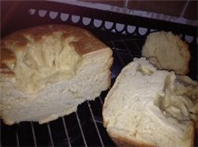I have been cooking gluten free, dairy free food for over a year now but never had the nerve to try and make my own bread. Until now. My mother in law has a bread machine and offered to lend it to me, as we have all had problems getting hold of the 'nice' Genius bread in the supermarkets of late. We consume rather a lot of GF bread, and waste a fair bit, as the loaves are often far from perfect and regularly fall apart - particulary the Warburtons version. So I decided I would see if it really is that hard to make good GF bread. Turns out - it is!
I followed the recipe on the side of the Doves Farm bread flour packet. It looked simple and I thought I did a good job. I know that getting your measurements is critical in bread making, so paid a lot more attention than normal. Slap dash is my usual style, but today I was like a junior scientist with all my measuring spoons and cups. I also read the machine instructions over a couple of times and felt relatively confident. It certainly seemed easy enough. Just measure out ingredients, put them all in the tin. Put the tin in the machine. Put the lid down and press the button.
I chose the hour long 'quick cycle' as my recipe seemed to be suitable and it didn't say on the pack how long to cook the bread for - if using a machine. I liked how quick and simple it seemed. I even decided that if I made a good job, I would continue to bake bread for my little ones as it was far simpler than driving to all of the local supermarkets searching in vain for an over priced, often nearly out of date loaf of Genius.
As you will see from the picture, the end result was far from pretty. I can also honestly say it tasted every bit as dreadful as it looked. It really lacked taste, so probably needed more salt. But I had read that too much salt can affect the end result. However, I did not deviate from the Doves Farm recipe, so unless I had an absent minded moment and read it wrong - that couldn't have been the problem.
I wondered if the cycle length was wrong. It did seem a bit short. I loved watching through the viewing window of the machine and was amazed as it worked on the dough and I saw it grow before my very eyes. It looked like the real thing. I remember from school that the resting and proving is very important and after about ten minutes of kneading the machine stopped and got warm, so I guess that was so the proving could start.
Then a short while later I noticed a nice cooking smell filling the kitchen so popped back in for another look. It looked like an overgrown scone. And that is how it remained. Even when the beeper went to signify the end of the cycle. It didn't look very brown. It looked like a massive half baked dumpling. Oh dear.
I put the oven on. I wondered if perhaps I could finish it off in a conventional oven. I knew I couldn't serve it in that state. It was obviously not cooked in the middle as there was a grey green smooth shine to the bottom 'creases' of the loaf. That puzzled me too. There was a baked-in 'kneading tool' shape. I guess that must always happen, as you cannot take the 'kneader/mixer' tool out. Does anyone know? Is that just part of the deal? You bake in a bread machine but allow for a hole in the bottom?
The bread went back into my fan assisted oven, which had been put on a low heat. I left it until I could see the outer crust browning and the green/grey areas changed to white. I took it back out, tore off a chunk - still tasteless and a very odd texture. Definitely more like an over cooked scone than anything else.
I am not really sure I can do anything with it other than whizz it up and turn it into some very useful breadcrumbs - I don't want to waste it.
Sophia was excited about making bread for the first time and was in bed before it was finished. She made me promise to let her try it for breakfast. So I have wrapped it up in foil and put it in the breadbin. It may work well sliced and toasted, perhaps with some chocolate spread or marmite on top to make it look a bit more appealing, and to 'cook' it a tiny bit longer.
If that doesn't work, I will have another try. I am tempted to bake it in the conventional oven next time. Not sure that the bread machine and I are destined to get along. The recipe and method for cooking bread in an oven looks every bit as simple as the bread machine version. If that fails then I will keep trying and looking for/asking for new recipes and methods until I get it right. I am determined to get this right and certainly not too proud to ask for a bit of help!

